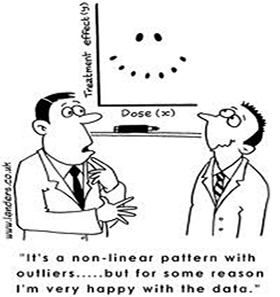Online Course
NRSG 795 – Biostatistics for Evidence-Based Practice
Module 7: Associations of Interval/Ratio Variables
Overview
Previous statistical tests learned (e.g., t-tests and ANOVAs) focused on testing differences between groups. What if instead of exploring hypotheses that needed to estimate differences in the means we now want to explore relationships or associations between our variables. Building on the previous modules which covered measures of central tendency and dispersion for single variables, this module and the next two will introduce you to statistics that examine associations among variables. The level of measurement of the variables (e.g., nominal, ordinal, interval, ratio) is fundamental to determining what analytical procedure to use. This module reviews the ways to describe and the statistical tests to measure the association (or relationship) among interval/ratio variables.
The selection of an appropriate test depends on several factors:
- Type of comparison being made;
- Number of groups being compared;
- The measurement level of the variables; and
- The extent to which the assumptions have been met.
Three common statistical tests that measure associations between continuous variables will be covered in this module:
- Pearson’s r:Testing between interval or ratio level variables (parametric)
- Spearman’s rho: Testing between ordinal or rank variables (non-parametric)
- Simple linear regression

Objectives
At the conclusion of this module, the learner will be able to:
- Determine the appropriate analytical approach to describe the relationships among variables and test for significant relationships.
- Create a scatterplot that illustrates the relationship between two interval/ratio level variables.
- Describe the findings of an association found in a table or figure.
- Perform a correlation and simple linear regression analyses and interpret the output
Directions
There are two subtopics in this module. The first describes the association using correlation. Pearson r and Spearman’s rho are the most common statistical tests to measure association between two variables and scatterplots are used to graphically display a correlation. The second topic begins to introduce linear regression in its simplest form where we only have one predicting variable.
This website is maintained by the University of Maryland School of Nursing (UMSON) Office of Learning Technologies. The UMSON logo and all other contents of this website are the sole property of UMSON and may not be used for any purpose without prior written consent. Links to other websites do not constitute or imply an endorsement of those sites, their content, or their products and services. Please send comments, corrections, and link improvements to nrsonline@umaryland.edu.